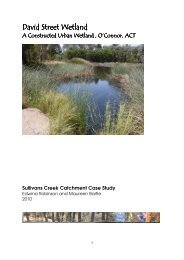4.2.2 Family Cyprinidae: Carps, Minnows etc. The Cyprinidae is one ...
4.2.2 Family Cyprinidae: Carps, Minnows etc. The Cyprinidae is one ...
4.2.2 Family Cyprinidae: Carps, Minnows etc. The Cyprinidae is one ...
Create successful ePaper yourself
Turn your PDF publications into a flip-book with our unique Google optimized e-Paper software.
unfortunately mosquito larvae do not figure prominently in their diet. Consequently, ‘Mosquitof<strong>is</strong>h’ should<br />
not be used as the common name as it implies some environmental or social benefit, which <strong>is</strong> largely<br />
incorrect. Eastern Gambusia are primarily carnivorous with the diet containing a range of small aquatic<br />
invertebrates and wind-blown terrestrial insects.<br />
<strong>The</strong>y are an aggressive species which will chase and fin-nibble f<strong>is</strong>h much larger than themselves. <strong>The</strong>y also<br />
prey on the eggs of native f<strong>is</strong>h and amphibians. Eastern Gambusia are implicated in the decline of some 30<br />
f<strong>is</strong>h species world-wide, at least 9 of which occur in Australia. <strong>The</strong>y have recently been l<strong>is</strong>ted as a key<br />
threatening process for amphibian populations in NSW, and are implicated in the decline of more than 10<br />
species of frogs in Australia.<br />
D<strong>is</strong>tribution, Abundance and Evidence of Change<br />
Native to rivers draining to the Gulf of Mexico, Eastern Gambusia were introduced into Australia in 1925.<br />
Further introductions were made by health authorities in the 1930s and the species was d<strong>is</strong>tributed to many<br />
military camps during the second World War. <strong>The</strong> species <strong>is</strong> now widely d<strong>is</strong>tributed throughout Australia.<br />
Eastern Gambusia are widespread throughout the warmer lowland waters in the Canberra region and<br />
have been recorded in the Molonglo, Murrumbidgee, lower Cotter, lower Paddys, and Queanbeyan rivers<br />
as well as Ginninderra, Jerrabomberra and Tuggeranong creeks. <strong>The</strong>y are commonly found in farm dams and<br />
shallow wetlands.<br />
<strong>The</strong>y have not been recorded from higher, cooler waters in the ACT including the Naas, Gudgenby, Orroral,<br />
and Tidbinbilla rivers, or the Cotter River upstream of Cotter Reservoir. <strong>The</strong>y can however survive in such<br />
waters if they are introduced, with the species recorded from the Snowy Mountains at an altitude of 1,300 m.<br />
F<strong>is</strong>hing Pressure Directed at th<strong>is</strong> Species<br />
NIL.<br />
Stocking Locations<br />
NIL.<br />
Conservation Reserves Where the Species Has Been Recorded<br />
• Woodstock Nature Reserve • Lower Molonglo Nature Reserve<br />
• Stony Creek Nature Reserve • Googong Foreshores<br />
• Bullen Range Nature Reserve • Canberra Nature Park<br />
• Gigerline Nature Reserve • Kosciuszko National Park<br />
• Molonglo Gorge Nature Reserve • *Tinderry Nature Reserve<br />
*= expected occurrence<br />
General References<br />
Aarn & Ivantsoff 2001; Arthington et al. 1986; Lloyd et al. 1986; Lloyd & Tomasov 1985; McDowall 1996d;<br />
Merrick & Schmida 1984; Pen & Potter 1971.<br />
Local References<br />
Faragher & Lintermans 1997; Lintermans. 1991b, 1995b, 1997a, 1998a,b, Lintermans et al. 2001;<br />
Lintermans & Rutzou 1990c.<br />
F<strong>is</strong>h in the Upper Murrumbidgee Catchment: A Review of Current Knowledge 67





